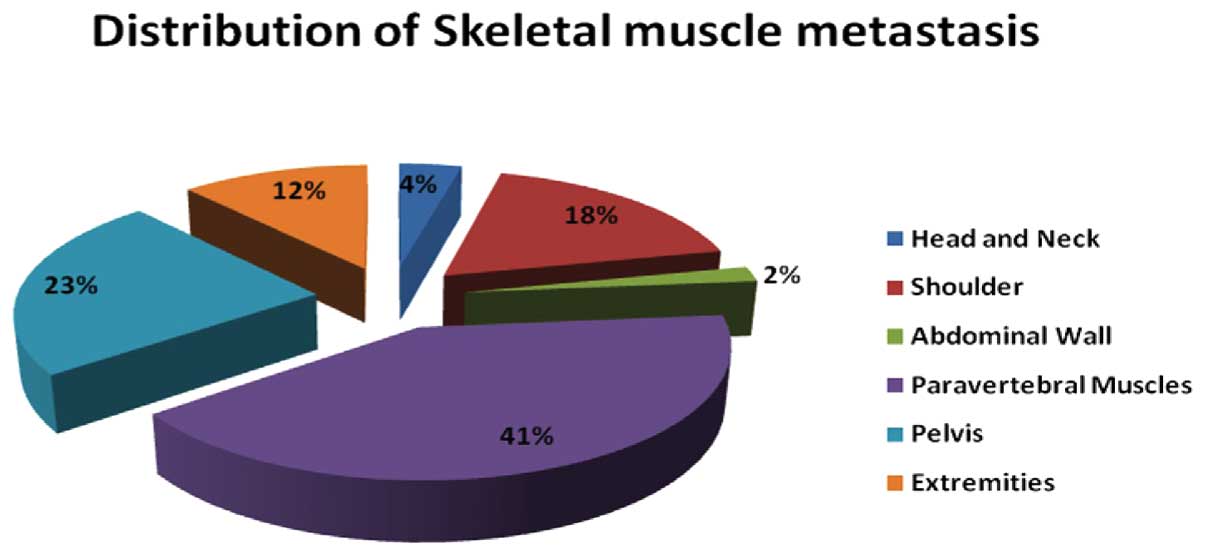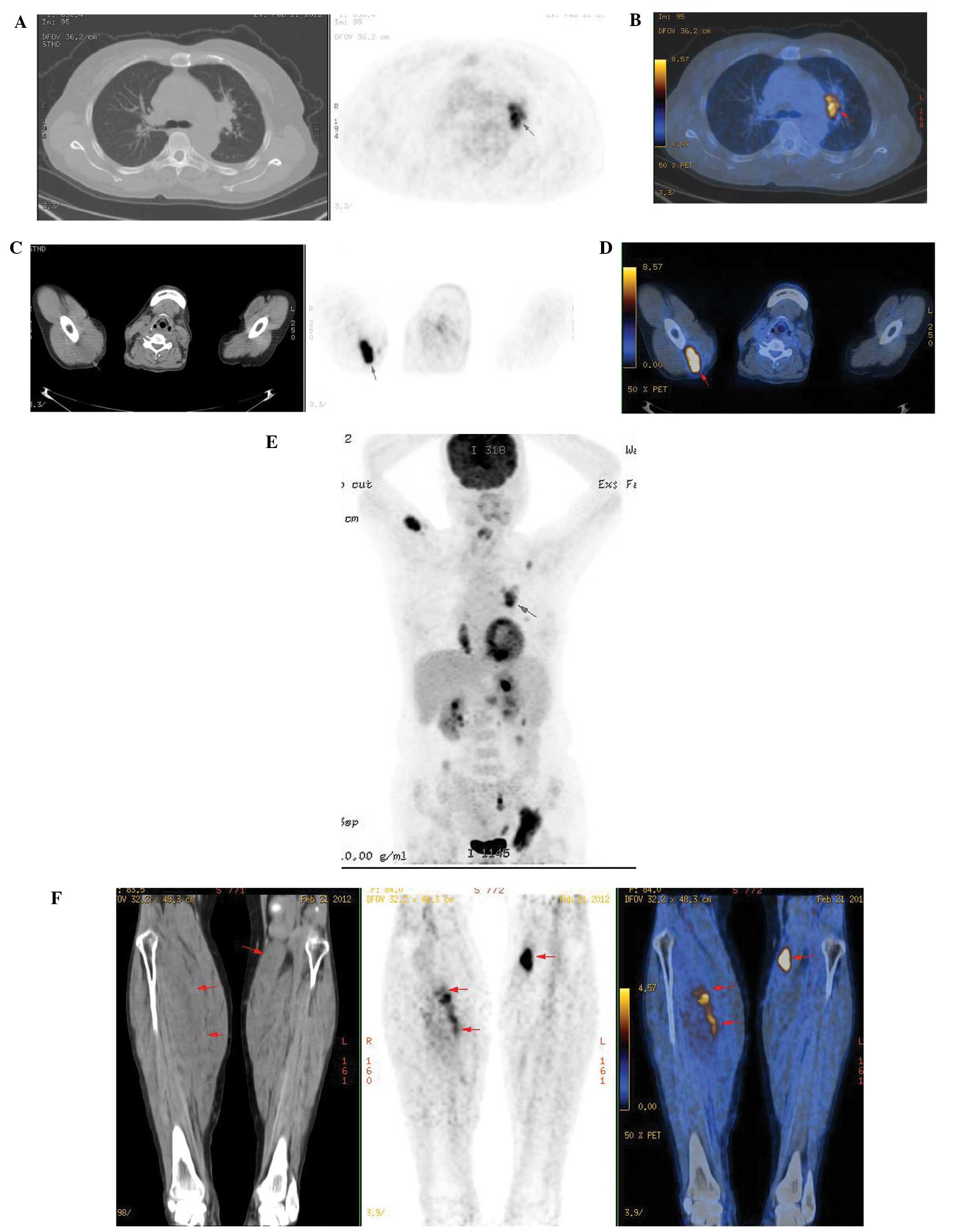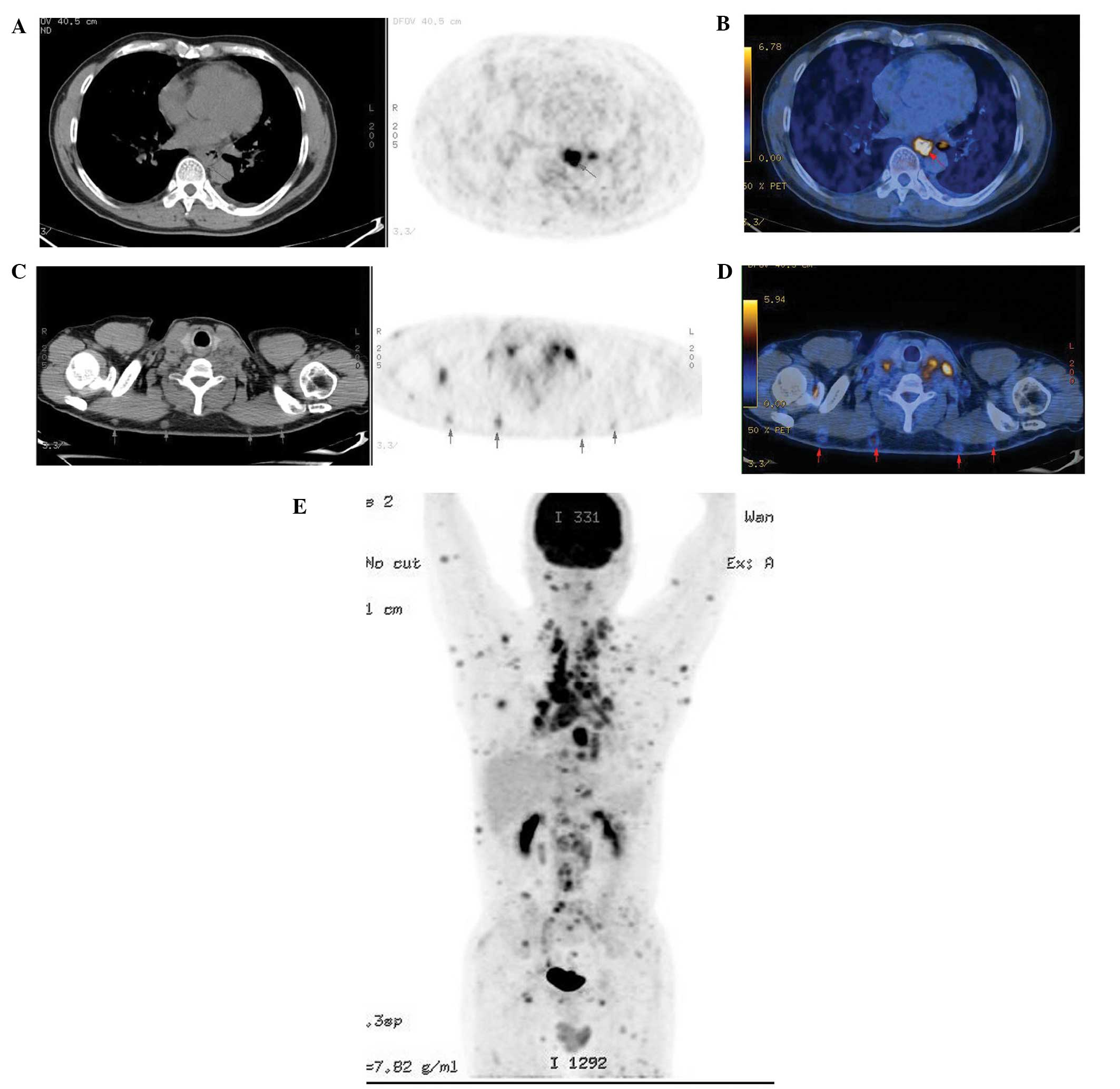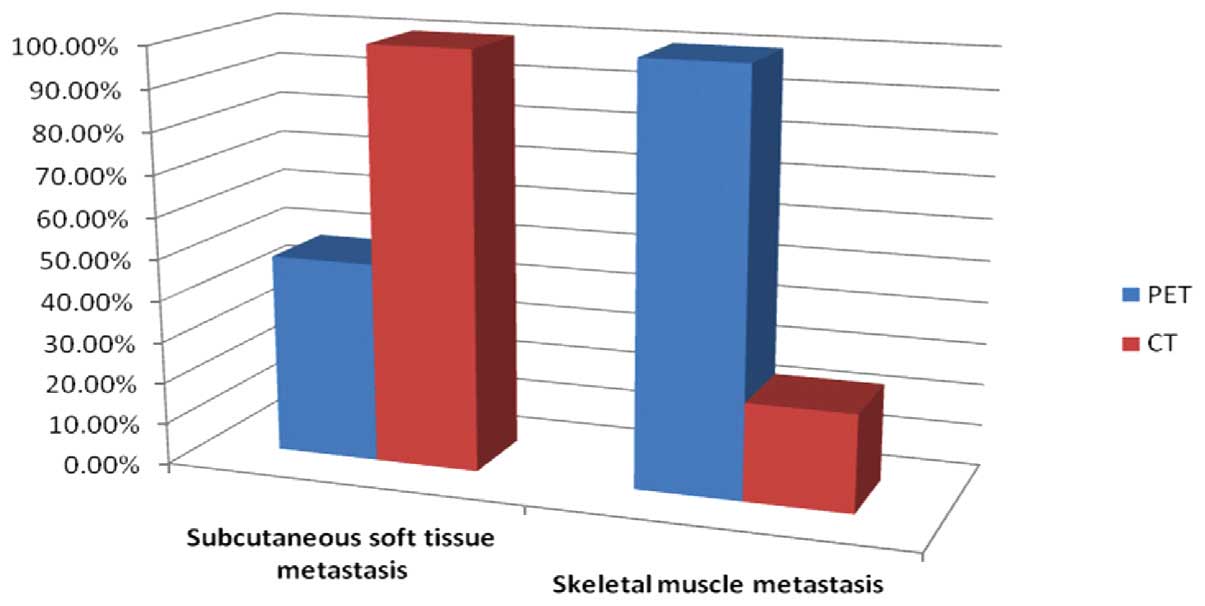The value of 18F-fluorodeoxyglucose positron emission tomography combined with computed tomography in the detection and characterization of soft tissue metastasis
- Authors:
- Published online on: June 12, 2014 https://doi.org/10.3892/mco.2014.312
- Pages: 761-766
Abstract
Introduction
Haematogenous soft tissue metastasis (STM), including skeletal muscle metastasis (SMM) and subcutaneous STM, is clinically uncommon (1,2). However, the detection of STM may affect cancer staging and prognosis. According to previous studies, lung cancer, gastrointestinal tumours and colorectal carcinoma are the primary malignancies that most commonly metastasize to the soft tissues (3,4). Metastases occur more rarely in association with other tumours, such as melanoma, breast cancer, pancreatic carcinoma and sarcoma of the muscle. A recent study by Surov et al retrospectively analysed the data of 5,170 patients with metastasized solid malignant tumours and concluded that SMM occurred more frequently in patients with carcinoma of the cervix and uterus, malignant melanoma and ovarian carcinoma (5). Statistical data from a study in Japan suggested that only 0.16% of patients with lung cancer developed SMM (6). In an autopsy series of patients with renal cell carcinoma, the prevalence of SMM ranged from 0.4 to 3.4% (7). In addition, the prevalence of SMM in patients with colorectal cancer was reported to be 0.028% (8). However, the prevalence of SMM did not exceed 5% in any of the different types of malignancy. In this study, we observed that the primary malignant tumour most frequently associated with SMM was lung cancer, in which adenocarcinoma accounted for 88.2% of the cases.
Metastatic tumours presenting as soft tissue masses are relatively rare and may be the source of diagnostic confusion clinically as well as pathologically (2). The differential diagnosis between STM and primary soft tissue sarcoma is crucial, as their treatment and prognosis are markedly different. The majority of the currently available clinical or radiological data on STM consist of isolated case reports or reviews and do not provide statistical evidence. In this study, we reviewed 17 cases of patients with STM who underwent 18F-fluorodeoxyglucose (18F-FDG) positron emission tomography (PET)/computed tomography (CT) scanning. The imaging and clinical data of these patients were retrospectively analysed. The aim of this study was to report the manifestations, origin and distribution of STM detected by 18F-FDG PET/CT and determine its value in the characterisation of STM. We also aimed to improve our knowledge of 18F-FDG PET/CT findings in the diagnosis of STM and determine its value in the staging of malignant tumours.
Materials and methods
Patients
The medical records of 17 patients with a total of 221 STM lesions were collected. The patients included 10 men and 7 women who underwent 18F-FDG PET/CT scanning at our hospital between August, 2010 and May, 2012. The cases were 15 of adenocarcinoma (15/17) and 2 of squamous cell carcinoma (2/17) and comprised 8 lung cancer cases (7 adenocarcinomas and 1 squamous cell carcinoma), 2 oesophageal carcinoma cases (1 squamous cell carcinoma and 1 adenocarcinoma), 5 cases of adenocarcinoma of the gastrointestinal tract and 2 cases of endometrial carcinoma. The majority of the patients had no obvious clinical symptoms, although 1 patient presented with a mass in the right lower limb and 1 patient exhibited subcutaneous diffuse small nodules on his body.
Inclusion and exclusion criteria
The criteria for inclusion were the presence of a pathologically proven malignancy and the development of metastatic soft tissue lesions in the skeletal muscles and/or subcutaneous tissues confirmed by correlations with surgical pathology, other imaging modalities, or clinical follow-up. The exclusion criteria included lymph node metastasis, such as to the axillary or inguinal lymph nodes; bone metastasis invading soft tissues; lymphoma; malignant melanoma; neurofibromatosis; and primary soft tissue sarcoma.
PET/CT scanning
All the patients underwent 18F-FDG PET/CT scanning for diagnostic evaluation using a GE Discovery STE 16PET/CT scanner (Discovery 16STE; GE Healthcare, Waukesha, WI, USA). All the patients were fasted for >6 h, with routinely measured blood glucose values of <6.60 mmol/l. A standard dose (0.1 mCi/kg) of an 18F-FDG tracer with a radiochemical purity of >95% was intravenously injected. The patients were then instructed to sit or lie quietly in an injection room without talking during the subsequent 40–60 min of the FDG uptake phase and were allowed to breathe normally during image acquisition without specific instructions. The patients were orally administered 500–800 ml of water to fill the gastrointestinal tract prior to scanning. True whole-body (TWB) 18F-FDG PET/CT scans acquired from the top of the skull through the bottom of the feet were obtained in 2 cases and limited whole-body (LWB) 18F-FDG PET/CT data acquired from the top of the skull to the upper thigh were obtained in 15 cases. The imaging parameters were as follows for CT scanning: 120 kV; 200–250 mA; thickness, 3.75 mm; pitch, 1.0; and for PET scanning: 3D scanning; scan 6–7 frames at 2 min per frame. Iterative attenuation correction reconstruction was performed to obtain axial, sagittal and coronal sections with a slice thickness of 3.75 mm for the PET, CT and fused PET/CT images.
Image analysis
All the acquired PET, CT and fused PET/CT images were separately analysed by 3 radiologists for a comparative analysis. Disagreements regarding the final conclusions were resolved by consensus. The maximum standardized uptake value (SUVmax) was measured in the abnormal radiation uptake areas with a semi-quantitative analysis. The PET positive standard was a lesion with a higher FDG uptake compared to the normal uptake of muscle and subcutaneous soft tissue. The CT evaluation of the STM included measurement of the greatest diameter and a density judgment (iso-, hyper-, or hypodense relative to the surrounding tissues). Given the limited anatomical delimitation of isodense muscular lesions from the surrounding normal muscular tissue on CT, the size of the lesions was estimated on the PET images.
Results
In 17 cases of STM, the primary tumour was an adenocarcinoma, accounting for 88.2% (15/17) of the cases. A total of 221 soft tissue lesions were present in the 17 patients. Thirteen patients had SMM, 2 patients had subcutaneous metastases and 2 patients had both muscle and subcutaneous STM. The incidence of muscle metastasis was 88.2%, while that of subcutaneous STM was 23.5%. PET/CT detected 51 muscle metastases, whereas PET detected all the muscle lesions with a 100% detection rate (51/51) (Table I and Fig. 1); the skeletal muscle lesions were hypodense in 12 and isodense in 39 of the 51 lesions (Fig. 2). A CT scan was only able to detect 12 of the 51 muscle metastases, resulting in a detection rate of 23.5% for isodense nodules (Fig. 2) with a maximum diameter of >2.0 cm and part of the lesion protruding from the surface. The paravertebral muscles were the most common site of metastasis, accounting for 29.4% of the metastases in this study (21/51). PET/CT detected 170 subcutaneous soft tissue nodules, whereas CT detected all 170 nodules with a maximum diameter of 0.3–1.2 cm, demonstrating a 100% detection rate (170/170); however, PET only detected 82 nodules with SUVmax values of 1.25–3.52, accounting for 48.2% (82/170) of the lesions (Fig. 3). The subcutaneous lesions were easily identifiable as hyperdense lesions on CT. No hyperdense skeletal muscle lesions were detected. The sensitivities of PET and CT in the detection of SMM and subcutaneous STM are shown in Fig. 4.
Table IDistribution of intramuscular metastasis on positron emission tomography/computed tomography. |
Discussion
Distant metastasis to the soft tissues, defined as metastasis to the skeletal muscle and subcutaneous tissues, has been rarely reported in the literature. However, subclinical metastases to the soft tissues may be more common than previously acknowledged. The overall prevalence of STM in oncologic patients may never be fully elucidated, as serial sectioning of all the soft tissues in the body at autopsy is not practical. Autopsy studies suggested that the frequency of muscle metastases is 0.8–16% (9). Spencer and Helm reported that the prevalence of skin metastasis of any cancer type varied between 0.75 and 9% (10). STM is generally more common during the progression of malignant tumours and is often accompanied by multiple organ and lymph node metastasis, whereas STM alone is quite rare. Metastasis occurs mainly in the muscles and subcutaneous soft tissues, with muscle metastasis being reportedly more common compared to subcutaneous STM. In this study, the incidence of muscle metastasis among this group of patients was 88.2%, while that of subcutaneous STM was 23.5%, similar to that reported by other studies (2).
Several factors are involved in STM, such as the pH value, the accumulation of metabolites and the local temperature of the soft tissue (3,11). In this study, the haematogenous route was the most favoured pathway. Malignant tumours metastasise into the musculature via venous vessels, particularly through the paravertebral venous plexus. Paravertebral veins have multiple connections with the inferior vena cava and the mesenteric venous system (12). In our study, the majority of SMM from pelvic and abdominal tumours were located in the paravertebral musculature (29.4%). Recently, Magee and Rosenthal (3) reported 8 biopsy-proven cases of skeletal metastases occurring in sites of previously documented skeletal muscle trauma (28.7% of the total patients) (13). It is possible that skeletal muscle trauma results in focal hyperaemia, which increases blood flow to the area, resulting in an increased susceptibility to metastatic seeding by circulating malignant cells. In the study by Magee and Rosenthal, metastases were discovered at an average of 28 months after the trauma (range, 16 months-6 years post-trauma).
STM exhibits a broad spectrum of radiological appearances. On plain radiographs STM generally presents as a soft tissue shadow; however, in the case of metastatic gastric and pancreatic carcinoma, calcifications within the soft tissue masses have been observed (14). Ossification within the muscle metastases of colorectal cancer has also been reported (15). CT provides a complete evaluation and definition of the extent of the mass in the skeletal muscle and its association to the adjacent bones, fascial planes, vessels and fat. Surov et al (5) described 5 different types of SMM based on the CT findings: focal intramuscular masses with homogeneous contrast enhancement (type I), abscess-like intramuscular lesions (type II), diffuse metastatic muscle infiltration (type III), multifocal intramuscular calcification (type IV) and intramuscular bleeding (type V), with type I being the most common type in their study (52.5%). Magnetic resonance imaging (MRI) is also able to detect metastatic lesions in skeletal muscle and it is particularly useful for estimating tumour size and location, as enhancement allows for differentiation between metastatic lesions and the surrounding skeletal muscle. MRI has been advocated as an indispensable tool for the diagnosis and treatment planning of patients with malignant soft tissue masses. However, MRI is not specific for STM. It was previously demonstrated that 18F-FDG PET/CT exhibited a higher sensitivity compared to MRI in detecting STM (16). However, there were false-positives in a few cases, which should be taken into consideration. Most PET facilities recommend at least 4 h of fasting prior to tracer injection as a standard guideline. A longer fasting time may increase the detection rate of STM.
The incidence of STM is quite low on conventional imaging, mainly due to the following reasons: i) inadequate understanding of clinicians, resulting from the low incidence of STM; ii) the presence of STM does not alter the late staging of the tumour and is hence undervalued by clinicians; and iii) lack of experience in the traditional imaging characteristics of STM.
PET/CT performs anatomical as well as metabolic imaging, is very sensitive in the detection of STM and provides more information for clinical tumour staging. PET is more sensitive in detecting lesions compared to CT before the density and morphology of the soft tissues are altered, providing a clear view of highly metabolic nodules within the soft tissue. In this study, the detection rate of SMM by PET was 100% (51/51), while that of CT was 23.5% (12/51), mainly due to the inability of CT to distinguish between the densities of muscle and metastasis. The glucose uptake of metastatic lesions is very high compared to normal muscle uptake, making PET more sensitive in detecting abnormally highly metabolic muscle metastases. A CT scan is able to clearly detect subcutaneous STM due to the density difference between fat and soft tissue lesions. Therefore, for subcutaneous STM, CT is able to clearly identify lesions of abnormal density in the subcutaneous fat. In this study, there were only 4 patients with subcutaneous STM, which was significantly lower compared to the number of patients with muscle metastasis; however, the number of subcutaneous STM lesions was significantly higher compared to that of muscle metastases. This is may be due to the limited spatial resolution of PET; in addition, the majority of subcutaneous STM in this study were small, with a maximum diameter of 0.3–1.2 cm. CT is able to detect lesions <1.0 cm, which may give a false-negative result on PET. Therefore, the detection rate of PET/CT for both muscle and subcutaneous metastasis is significantly better compared to that of PET or CT alone.
STM may present in a number of muscular and subcutaneous sites across the body with a ratio higher than 1.5:1 (4) or 1.2:1 (15). In this study, the ratio was 1:3.3 (51/170), suggesting that subcutaneous STM may have been underreported in the literature.
In oncology, whole-body PET/CT is typically performed from the top of the skull to the upper thigh (LWB 18F-FDG PET/CT), since the majority of FDG-avid lesions are expected to be within this field-of-view (FOV). If the primary tumour or the suspected metastatic lesions are outside the LWB, the FOV is then extended to cover this site, thus allowing a proper diagnosis, staging and restaging. In this study, 2 patients with palpable masses in their lower limbs underwent TWB PET/CT. The results revealed that there were metastatic lesions in the lower limbs. Nguyen et al (17) reported that STM were detected with TWB 18F-FDG PET/CT and compared the findings to those of the LWB FOV, indicating that the LWB FOV may underestimate the true extent of STM by missing lesions outside the FOV.
STM should be differentiated from primary soft tissue sarcoma. Intramuscular metastases generally present as a painful mass, which is commonly firm and tender (usually >5 cm in diameter) (18, 19). This presentation may be an important clue to suggest metastasis over the more common soft tissue sarcoma, which presents as a soft, painless mass (11). Whole-body PET/CT imaging may reveal the primary tumours of the STM, which is helpful for differential diagnosis. In this study, 1 patient presented with squamous cell carcinoma of the calf muscle and PET/CT identified oesophageal carcinoma as the primary tumour. Therefore, the primary tumour detection capability of PET/CT combined with pathological diagnosis was helpful in determining the treatment and prognosis of the patient. Although the majority of metastatic soft tissue tumours have a history of primary tumour, it may be difficult to identify the primary tumour, as explained by Plaza et al (2), who reported that 13.5% of soft tissue STM had no primary tumours. If there are no primary tumours identified, the differential diagnosis includes primary soft tissue sarcoma, lymphoma, malignant melanoma and neurofibromatosis. The differential diagnosis relies mainly on pathology and immunochemistry (20). In this study, PET/CT detected the primary tumours in all the patients, combined with a pathological and clinical history for an accurate diagnosis.
In conclusion, based on our study and the currently available literature, the incidence of subcutaneous STM may have been underreported in the literature. The prognosis of the patient may vary depending on the accurate diagnosis of STM. PET/CT not only detects STM, but also plays an important role in the detection of the primary tumours during tumour staging and restaging. Therefore, PET/CT is crucial for the differential diagnosis of STM.
References
|
Molina-Garrido MJ and Guillén-Ponce C: Muscle metastasis of carcinoma. Clin Transl Oncol. 13:98–101. 2011. View Article : Google Scholar | |
|
Plaza JA, Perez-Montiel D, Mayerson J, et al: Metastases to soft tissue: a review of 118 cases over a 30-year period. Cancer. 112:193–203. 2008.PubMed/NCBI | |
|
Magee T and Rosenthal H: SMM at sites of documented trauma. AJR Am J Roentgenol. 178:985–988. 2002. View Article : Google Scholar : PubMed/NCBI | |
|
Koike Y, Hatori M and Kokubun S: Skeletal muscle metastasis secondary to cancer - a report of seven cases. Ups J Med Sci. 110:75–83. 2005. View Article : Google Scholar : PubMed/NCBI | |
|
Surov A, Hainz M, Holzhausen HJ, et al: Skeletal muscle metastases: primary tumours, prevalence, and radiological features. Eur Radiol. 20:649–658. 2010. View Article : Google Scholar : PubMed/NCBI | |
|
Tuoheti Y, Okada K, Osanai T, et al: Skeletal muscle metastases of carcinomas: a clinicopathological study of 12 cases. Jpn J Clin Oncol. 34:210–214. 2004. View Article : Google Scholar : PubMed/NCBI | |
|
Nabeyama R, Tanaka K, Matsuda S and Iwamoto Y: Multiple intramuscular metastases 15 years after radical nephrectomy in a patient with stage IV renal cell carcinoma. J Orthop Sci. 6:189–92. 2001.PubMed/NCBI | |
|
Hasegawa S, Sakurai Y, Imazu H, et al: Metastasis to the forearm skeletal muscle from an adenocarcinoma of the colon: report of a case. Surg Today. 30:1118–1123. 2000. View Article : Google Scholar : PubMed/NCBI | |
|
Sudo A, Ogihara Y, Shiokawa Y, et al: Intermuscular metastasis of carcinoma. Clin Orthop Relat Res. 296:213–217. 1993. | |
|
Spencer PS and Helm TN: Skin metastasis in cancer patients. Cutis. 39:119–121. 1987. | |
|
Koike Y, Hatori M and Kokubun S: Skeletal muscle metastasis secondary to cancer - a report of seven cases. Ups J Med Sci. 110:75–83. 2005. View Article : Google Scholar : PubMed/NCBI | |
|
Nabi G, Gupta NP and Gandhi D: Skeletal muscle metastasis from transitional cell carcinoma of the urinary bladder: clinicoradiological features. Clin Radiol. 58:883–885. 2003. View Article : Google Scholar : PubMed/NCBI | |
|
Yiotakis J, Hantzakos A, Kostakopoulos A and Adamopoulos G: Intramasseteric metastasis of renal cell carcinoma. J Laryngol Otol. 115:65–67. 2001. View Article : Google Scholar : PubMed/NCBI | |
|
Kaira K, Ishizuka T, Yanagitani N, et al: Forearm muscle metastasis as an initial clinical manifestation of lung cancer. South Med J. 102:79–81. 2009. View Article : Google Scholar : PubMed/NCBI | |
|
Stabler J: Case report: ossifying metastases form carcinoma of the large bowel demonstrated by bone scintigraphy. Clin Radiol. 50:730–731. 1995. View Article : Google Scholar : PubMed/NCBI | |
|
Pfannenberg C1, Aschoff P, Schanz S, et al: Prospective comparison of 18F-fluorodeoxyglucose positron emission tomography/computed tomography and whole-body magnetic resonance imaging in staging of advanced malignant melanoma. Eur J Cancer. 43:557–564. 2007. | |
|
Nguyen NC, Chaar BT and Osman MM: Prevalence and patterns of soft tissue metastasis: detection with true whole-body F-18 FDG PET/CT. BMC Medical Imaging. 7:1471–2342. 2007. View Article : Google Scholar : PubMed/NCBI | |
|
Glockner JF, White LM, Sundaram M and McDonald DJ: Unsuspected metastases presenting as solitary soft tissue lesions: a fourteen-year review. Skeletal Radiol. 29:270–274. 2000.PubMed/NCBI | |
|
Kim CJ, Day S and Yeh KA: Metastatic soft tissue squamous cell carcinoma. Am Surg. 67:111–114. 2001.PubMed/NCBI | |
|
Pretorius ES and Fishman EK: Helical CT of skeletal muscle metastases from primary carcinomas. AJR Am J Roentgenol. 174:401–404. 2000. View Article : Google Scholar : PubMed/NCBI |













